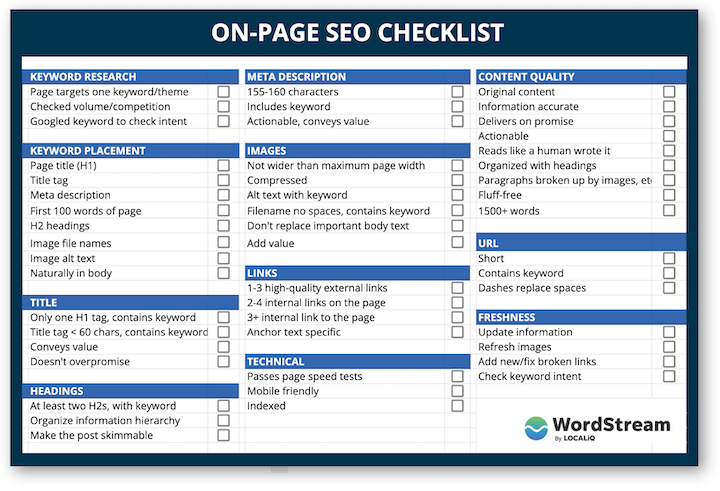Every page should have one primary keyword. It should be used in the H1 tag, as well as in a relevant image alt text and in the page meta description (which appears on SERPs). Include one secondary keyword per page.
The content on a page must meet high standards. It should be accurate, up-to-date and free of grammatical errors.
Keywords
When implementing on-page SEO, it is important to focus on keywords. A good keyword research tool will help you uncover popular search queries and find relevant variations. This information can be used to create more effective content. It will also help you optimize your page title and URL slug, which are crucial ranking factors for on-page SEO.
It is essential to include your primary keyword in your title tag. This is the most basic element of on-page SEO and is one of the easiest to implement. However, make sure your title isn’t too long and avoid keyword stuffing. The length of the title tag should be between 50 and 60 characters, including spaces.
Another important task on this checklist is ensuring that your content is optimized for mobile users. This will boost your search engine visibility and increase user engagement. You can check your mobile-friendliness with tools like Google’s Mobile-Friendly Checker or Semrush’s SEO Content Template. The latter also helps you analyze competitors’ keyword usage.
Your content should be high-quality to rank higher in the SERP and keep users engaged. It should be factually correct and free of spelling and grammatical errors. In addition, it should be well-structured and include semantically-related words to the keyword topic. It should also include an author byline and a link to the author’s website.
Metadata
Metadata is a set of descriptive information about data or objects. It enables users to find, identify and understand them. It is used in a wide variety of applications, including in image and video repositories and content management systems. Metadata can also be described in a more structured way using schemas, a standardized vocabulary for describing the format and relationships of data.
Unique metadata standards exist for many disciplines (e.g., museum collections, digital audio files). These may include additional, specific details that are not available in standard metadata formats. For example, a CD may include metadata describing the artists who performed on it.
A common misunderstanding of metadata is its name, which derives from the Greek word for “data beyond data.” The term is misleading because it suggests that metadata is a separate entity from data. In fact, metadata is a critical component of the data it describes.
For example, the H1 tag is a piece of metadata that tells search engines what your page is about. It is usually short and should contain your primary keyword. It should also be readable and enticing for readers to click on it. Creating a good H1 tag is not easy, but it’s a critical part of on-page SEO. The first step is to choose a good keyword that is searched often by your target audience.
On-page optimization
A webpage can be optimized in a variety of ways to boost its ranking on SERPs. These on-page optimizations are generally invisible to visitors, but can impact the way a page ranks by improving the relevance of its keyword and increasing search engine traffic. This free on-page SEO checklist template will help you ensure your pages are optimized correctly.
Title tags are one of the most important on-page SEO elements. They tell Google what the page is about, so it is crucial to get them right. Title tags should be unique, descriptive and include the keyword to be effective. In addition, the keyword should be included in the meta description.
URLs are another on-page element that should be optimized to improve SERPs. Including the keyword in the URL tells search engines what a page is about, and it also helps to establish credibility.
Using the on-page SEO checklist template will help you optimize all of your website’s content. This includes articles, blog posts and other types of pages. It is a good idea to work through the checklist on a page-by-page basis. In addition, it is important to keep in mind that SEO is not a quick fix. It takes time and effort to build a strong foundation that will help your website rank higher. However, once you have a solid foundation, you can see long-term results.
Link building
Link building is the process of increasing the number and quality of inbound links to a webpage. This improves the page’s search engine optimization (SEO) ranking, and can increase its visibility in search results. It also helps build brand awareness, attract new visitors, and improve conversions. However, before you start trying to get more inbound links, it’s important to understand how SEO works and the different factors that influence search engine rankings.
The first step in a successful link building campaign is to create content that is worth linking to. This means that your content must be valuable, interesting, or useful to readers. It’s also important to avoid keyword stuffing. Search engines will penalize sites that try to manipulate their algorithms by adding too many keywords to their pages.
You can use a variety of tools to help you improve your on-page SEO, including the free on-page SEO checklist from Semrush. This tool allows you to optimize your content for the most important on-page SEO elements and track your progress. It also provides a mobile-friendly test, which can help you identify problems with your site’s mobile-friendliness.
It’s also important to check out your backlinks regularly. If you have any low-quality links, it’s best to remove them as soon as possible. This will prevent you from getting a manual penalty from Google.

